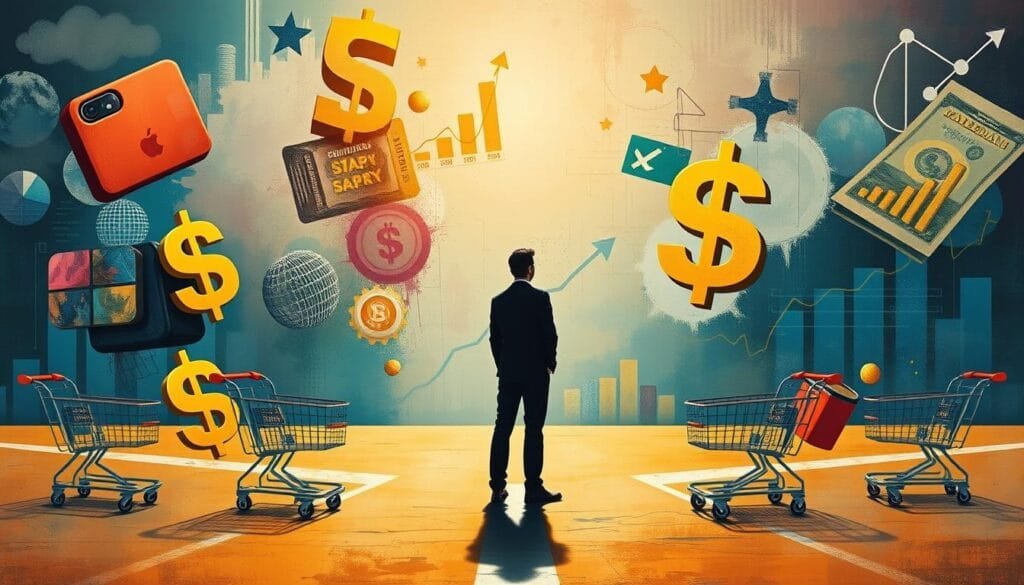In today’s economy, one key player stands out: the economic buyer. Experts like Rich Liu highlight the need to grasp how consumers make choices. They help us see how needs and smart decisions shape buying habits.
Our guide delves into what makes consumers tick. We examine how they balance wants with reality, aiming to make sense of a complex market. If you’re curious about economic trends or what drives people to buy, this guide is your navigation tool.
Key Takeaways
- Understand the role of the economic buyer in striking a balance between product advantages and financial sensibility.
- Discover how consumer behavior influences economic decision-making at both macroeconomic and individual levels.
- Explore the implications of recent economic data, from GDP and unemployment rates to changes in the Consumer Price Index.
- Learn how global events, such as a release of strategic petroleum reserves, can impact purchasing patterns.
- Recognize the psychological undercurrents that drive nearly 95% of our consumer decisions.
- Consider how behavioral economics and consumer psychology shape the strategies that successful businesses deploy.
- Gain insights into the elements of scarcity, trust, and incentives that are pivotal in guiding consumer preference and choice.
Decoding the Economic Buyer: The Heart of Every Transaction
The economic buyer is key in market strategies and sales processes. This person, like CFOs or department heads, has big buying power in their company. Knowing who these buyers are and their decision-making can improve sales tactics a lot.
Who is the Economic Buyer?
In the MEDDIC sales method, the economic buyer has a major role. They decide on big purchases. Their “yes” can make a sale happen by allowing budget use. This is because they can say yes to buying big things, like software or hardware.
Understanding the Role of Economic Buyers in Sales Strategies
To win in sales, understanding the economic buyer is crucial. Sales people need to show how their offers can save money or make money. Using MEDDIC, they can really get what the buyer needs. Rich Liu says we must talk about their main worries and show real value.
The Impact of Economic Buyers on Market Dynamics
Economic buyers change market trends. Their choices affect sales and marketing plans. For example, TripActions shifted its message to meet high-level needs of these buyers. This shows understanding economic buyers can greatly help a business’s market strategy and outcomes.
The Psychology Behind Purchasing: Why We Buy What We Buy
Our buying habits are closely linked to consumer psychology. Each part of the market affects our choices. Knowing why and how we buy improves marketing and makes customers happier.
Consumer psychology looks at what drives our shopping habits. It uses ideas from famous theories to explain our behavior. This helps us know why we decide to buy something.
These psychological insights are key for marketers. They can match their strategies to what customers want and do. Understanding how feelings and thinking affect buying can give marketers an advantage.
| Psychological Factor | Impact on Purchasing Behavior |
|---|---|
| Maslow’s Hierarchy of Needs | Tailoring products to meet varying needs from basic to self-fulfillment influences consumer engagement and satisfaction. |
| Personality (Five Factor Model) | Personality traits guide buying patterns; for example, a high degree of openness might correlate with the purchase of novel products. |
| Emotional Factors (Elaboration Likelihood Model) | Emotional appeals in advertising can override rational evaluation, leading to impulse purchases. |
| Cognitive Biases (e.g., Bandwagon Effect) | Understanding common biases can help marketers create campaigns that resonate better and influence buyer’s choices. |
| Social Factors (e.g., Peer Influence) | Purchase decisions are often swayed by social circles, stressing the importance of targeted social proof in marketing. |
Realizing these factors helps predict buying behavior. It shapes better market strategies. This doesn’t just help marketers but also guides consumers to smarter, more satisfying purchases.

The mix of consumer psychology and market stimuli goes beyond just buying patterns. It works towards a marketplace that is more understanding and impactful. With consumers’ behavior getting more complex, psychology’s role in marketing remains crucial.
Exploring Microeconomics: The Study of Consumer Behavior
Microeconomics helps us understand how utility analysis, price sensitivity, and opportunity costs affect buying choices. We’ll see how these factors guide consumer actions in economics books. Outside the classroom, decisions are often influenced by biases and feelings.
Utility and Consumer Choice
Utility is a key idea in economics, touching on the work of Adam Smith and Daniel Kahneman. It shows that people want to get the most happiness while sticking to a budget. This idea helps explain why we choose certain products over others.
However, emotions like the fear of losing can alter our choices. Even if we aim to make logical decisions, the dread of a loss can lead us to make irrational ones. This shows the gap between theory and real-life actions.
Price Sensitivity and Demand
How consumers react to price changes is crucial for understanding demand. When prices go down, we usually buy more basics but might splurge on luxury items when we have extra cash. This shows the complex relationship between what things cost, their perceived value, and our buying habits.
Opportunity Costs in Everyday Purchases
Every choice comes with the cost of not picking another option. For instance, choosing college over working right away means missing out on earnings. These decisions force us to weigh what we gain against what we give up.
Grasping these economic concepts helps us make sense of how people decide what to buy. It aids in crafting better strategies for businesses and consumers in a world full of different tastes and economic challenges.
| Concept | Application in Consumer Decision-making | Influence on Market Trends |
|---|---|---|
| Marginal Utility | Guides choices based on incremental satisfaction | Impacts goods consumption patterns |
| Price Elasticity | Affects responsiveness to price changes | Shapes demand curves |
| Opportunity Costs | Drives trade-offs in purchasing | Influences consumer budget allocation |
Competition and Its Effect on Consumer Choices
In our study of competition, we see how it shapes what consumers can buy. It affects prices and can even cause market problems if not watched closely. Competition changes how companies act and what choices consumers have.
Many industries are merging, changing the competition field. Since the 1990s, over 75% of U.S. industries have seen more company mergers. This has big effects on how markets operate and on pricing strategies.
| Industry | Price Increase After Merger | Impact on Competition Level |
|---|---|---|
| Hospitals | Above 20% | Significant reduction in competition |
| Airlines | 7.2% – 29.4% | Decreased competition in affected markets |
| Insurance | 7% | Increased market power |
| Beverage (Beer) | 6% – 8% | Tacit coordination increases |
Mergers and acquisitions lower competition, affecting prices and hurting consumers. Prices tend to go up by 7.2% on average after mergers. Healthcare prices rise even more.
We must understand how these changes impact consumer options. Encouraging fair competition means transparent business practices and fair access to markets. This helps prevent market failures and keeps customers happy.
Competition is key for markets to work well and for people to get good deals. But, we must manage it wisely to help both shoppers and businesses.

“a person who buys things economic terms”: Unpacking the Jargon
Exploring the world of economic terminology and fiscal language can be tricky. But, getting to know these terms helps us improve our consumer literacy. Let’s simplify these terms to better understand how they apply in our daily lives and influence what we buy.
Defining Key Economic Terms for Consumers
Consumer application of economic terms starts with key concepts like supply and demand, consumerism, and market economies. For example, market economies in the USA and Canada follow these concepts. They affect everything from how much things cost to how easy they are to buy.
How Economic Terms Affect Buying Decisions
Knowing economic terminology shapes our decision-making factors a lot. Understanding terms like ‘marginal utility’ and ‘opportunity costs’ helps us see the pros and cons of our purchases. This knowledge greatly impacts our fiscal decision-making.
Applying Economic Terms in Everyday Shopping
Using economic principles as a consumer shows in knowing why we buy things the way we do. It sorts us into buyer types like loyal, impulsive, or those shopping out of necessity. This helps us shop smarter and more informed.

| Market Type | Characteristics | Examples |
|---|---|---|
| Auction Markets | Bidding-based, competitive pricing | Livestock, Art Pieces |
| Financial Markets | Trade of securities, currencies | NYSE, LSE |
| Illegal Markets | No government oversight | Varies by region |
| Market Economies | Led by supply and demand | USA, UK |
Understanding this doesn’t just help with economic terminology. It also enables us to make choices that are good for our wallets. It increases our power to improve our own financial health and impacts the economy at large.
Conclusion
We’ve looked into the complex role of the economic buyer and the forces of microeconomics that influence what people buy. We see now that being smart with money plays a big part in our ability to make good choices in the market. With this knowledge, people can make better decisions when buying things. Spending is not only important for the economy but also shows us what society values. This has a big impact on the GDP and shapes our economy.
We’ve discovered how crucial it is for shoppers to be informed. Knowing more about the market is key. This knowledge helps us not just spend money, but do it wisely and with purpose. We’ve learned that our shopping habits have big impacts. They can affect the environment, society, and even our own happiness. Our choices can have two sides – good and bad.
Seeing the effects of our shopping choices on companies and trends is eye-opening. Every buying decision carries a lot of weight. By making thoughtful choices and supporting fair policies, we can aim for a fair economy. This approach values real worth over just status. It’s not just about buying. It’s about understanding our economy better and making choices that help everyone.
FAQ
Who is considered an economic buyer in the MEDDIC sales methodology?
The economic buyer in the MEDDIC sales methodology is the decision-maker with the budget power. They usually hold pivotal positions like CFOs or heads of departments. They play the key role in financial decisions within their organizations.
How can understanding the economic buyer influence our sales strategies?
Understanding who the economic buyer is can change our sales game. These decision-makers look at the value our product or service adds. By aiming our efforts at the economic buyer and solving their concerns, we boost our chances to close a deal.
What impact do economic buyers have on market dynamics?
Economic buyers shape the market because their choices drive company revenues and positions. Their feedback might push us to tweak our product messages. This can change the competitive landscape and our ability to scale.
Why is understanding consumer psychology important in purchasing behavior?
Getting why people buy is crucial as preferences are shaped by usefulness and happiness from products. In times of economic change, buyers think hard about their choices. Knowing what drives their decisions can lead us to better sales strategies.
How do concepts like utility and consumer choice play a role in microeconomics?
In microeconomics, utility is how happy goods and services make us, which drives our choices. The idea that more of a good means less happiness affects how we decide. These key ideas help analyze how and why consumers buy.
What is the relationship between price sensitivity and consumer demand?
Price sensitivity impacts how demand changes with price shifts. When sensitivity is high, small price changes can greatly affect whether people buy. This tells us much about market dynamics and product demand elasticity.
How do opportunity costs influence everyday purchasing decisions?
Opportunity costs are about what we give up when we choose one thing over another. These costs underline our daily choices, showing the trade-offs and their effects on our wallets.
How does competition affect industry pricing and consumer choices?
Competition levels set the stage for pricing and choices in an industry. More competition often leads to lower prices and more options. With less competition, we see higher prices and fewer choices, guiding consumer decisions.
What is the importance of defining key economic terms for consumers?
For consumers, understanding economic terminology clarifies the complexity of market mechanisms. Clear terms lead to better decisions, reflecting their economic limits and wants.
How do economic terms such as marginal utility and opportunity costs affect buying behavior?
Marginal utility and opportunity costs influence what we feel a product is worth. By considering these, consumers weigh pros and cons, shaping their buying habits and desires.
Can understanding economic terms improve our daily shopping experience?
Yes, knowing economic terms changes the shopping game. It helps us see how market factors like price sensitivity play out. This understanding guides us towards smarter buying choices, in line with our finances.
